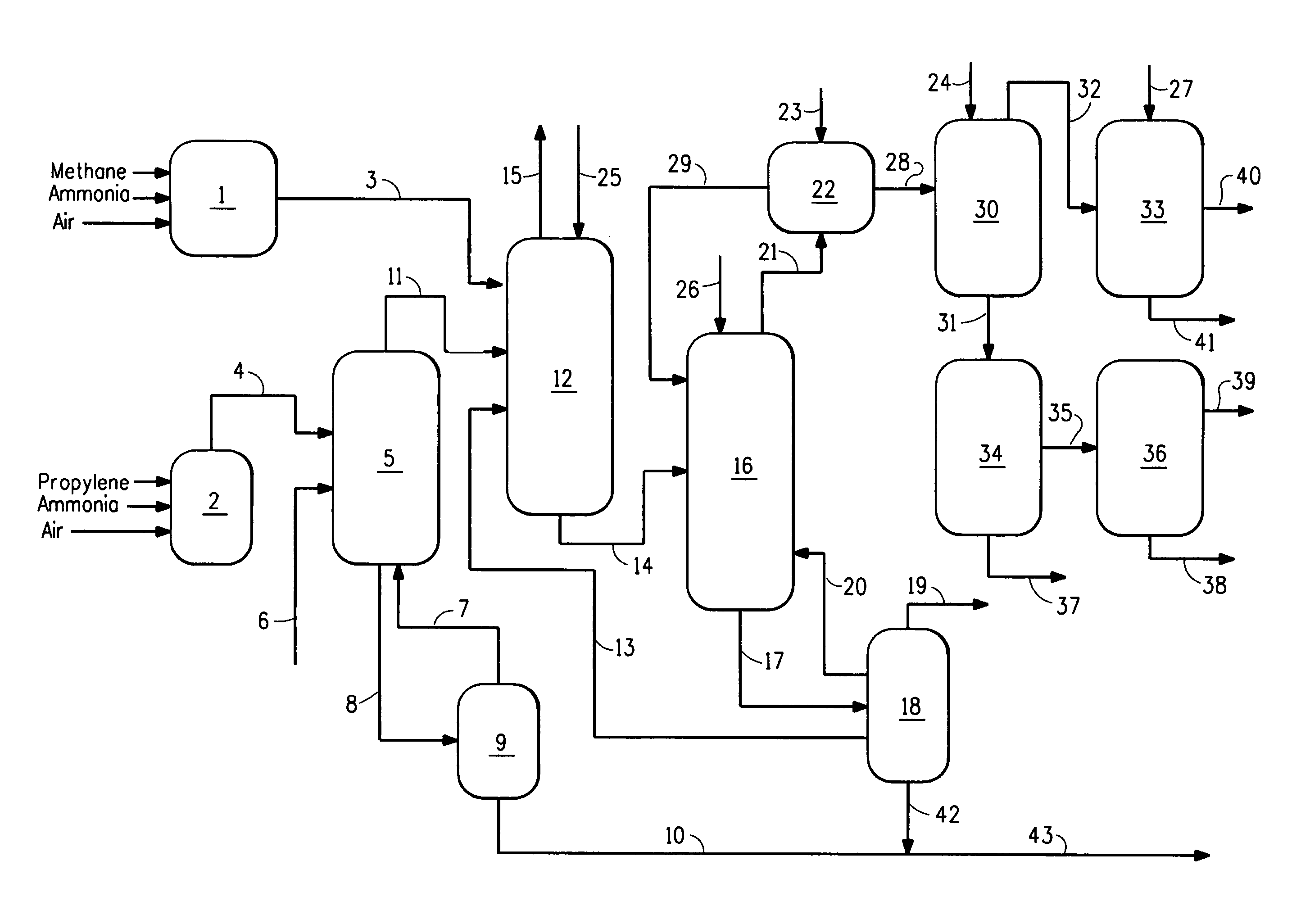Process to C-manufacture acrylonitrile and hydrogen cyanide
a technology of acrylonitrile and hydrogen cyanide, which is applied in the direction of hydrogen cyanide preparation/purification/separation, separation processes, organic chemistry, etc., can solve the problems of unfavorable hcn polymerization, polymer formation and fouling in downstream equipment, and more frequent catalyst replacement, so as to achieve the reduction of the relative weight ratio of acrylonitrile to hydrogen cyanide and the effect of substantially preventing hcn
- Summary
- Abstract
- Description
- Claims
- Application Information
AI Technical Summary
Benefits of technology
Problems solved by technology
Method used
Image
Examples
examples
[0052]The following Examples were performed in a flow system as illustrated in FIG. 1. For the Comparative Example, there was no HCN synthesis reactor and no HCN product stream present. The ACRN product stream (reactor effluent from acrylonitrile synthesis reactor) was treated in a quench column to reduce temperature to 46° C. and then fed to an absorber column. The HCN product stream (in Examples 1 and 2 only) was similarly quenched to a temperature of about 55° C. was combined with the ACRN product stream in the absorber column. The product stream (ACRN or combined stream) passed from the absorber column to a recovery column to a decanter, wherein an aqueous layer was separated from an organic layer, with the aqueous layer recycled to the recovery column and the organic layer fed to a heads column where crude HCN was separated from crude ACRN. Crude ACRN was removed from the bottom of the heads column and sent to a drying column and then further purification and packaging. Crude H...
example 1
[0056]The process of the Comparative Example was repeated, with the following changes. A hydrogen cyanide reactor was operated producing an HCN product stream, which was combined with quenched stream from the ACRN process in the ACRN recovery / purification system used in the Comparative Example and as described above. ACRN was produced at the same rate as was produced in the Comparative Example. The amount of HCN produced from the ACRN reactor and hydrogen cyanide reactor was about 2.5 times the amount produced in Comparative Example.
[0057]High concentration of HCN in the streams, especially in the recovery column and decanter provide greatest concern for safety, where there are high concentrations of HCN in organic phases, susceptible to polymerization. In this Example 1, the pH was monitored and controlled at the absorber column, recovery column, decanter, heads column, and drying column by adding glycolic acid to the column or decanter, as needed to stabilize against polymerizatio...
example 2
[0060]The process of Example 1 was repeated, but the amount of HCN produced was varied to provide ratios of ACRN to HCN of 2 to 1, 4 to 1 and 5 to 1 to show the ability to vary rate of co-manufacture of HCN and ACRN. In this Example, the pH was monitored and controlled at the absorber column, recovery column, decanter, heads column, and drying column by adding glycolic acid to the column or decanter, as needed to stabilize against polymerization. Thus, the process of this invention can provide varying amounts of HCN relative to ACRN with minimal need for added investment in recovery and purification operations. Polymerization of HCN was substantially prevented.
PUM
| Property | Measurement | Unit |
|---|---|---|
| pH | aaaaa | aaaaa |
| weight ratio | aaaaa | aaaaa |
| pH | aaaaa | aaaaa |
Abstract
Description
Claims
Application Information
 Login to View More
Login to View More - R&D
- Intellectual Property
- Life Sciences
- Materials
- Tech Scout
- Unparalleled Data Quality
- Higher Quality Content
- 60% Fewer Hallucinations
Browse by: Latest US Patents, China's latest patents, Technical Efficacy Thesaurus, Application Domain, Technology Topic, Popular Technical Reports.
© 2025 PatSnap. All rights reserved.Legal|Privacy policy|Modern Slavery Act Transparency Statement|Sitemap|About US| Contact US: help@patsnap.com


